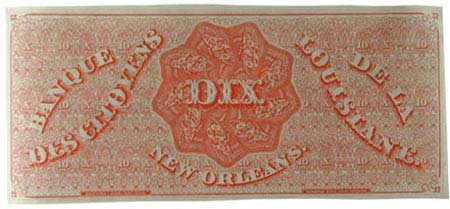Who put the “Dixie” in “Dixieland”?
By Jim Ivy
We call it Dixieland Jazz but have you ever wondered how the name “Dixieland” came about? Well, we can thank the Kaintocks for the term. The Kaintocks were the men who crewed the keelboats carryng cargo on the Mississippi river.
 |
The American monetary system was in shambles when the United States purchased Louisiana. To ease the situation, the Citizens Bank of Louisiana started issuing ten-dollar notes. On one side, the notes were printed in English, the other side in French. The word “ten” in French is “DIX”, and that is simply what the river men started calling the strange notes. More than one dix were called “dixies”. Before long, “Dixie” became a place name – denoting New Orleans at first, and then becoming the name for all of the South.
 |
Of course, there are other explanations that have been put forward to explain how the word “Dixie” came about. One story supposes that a kindly plantation owner, Mr. Dix, who owned a farm in New York, sent sold some of his slaves. According to this version of the story, the slaves wished they were back on Mr. Dix’s farm and would often comment “I wish I was back at Dix’s”.
Another theory is that the word “Dixie” is derived from Jeremiah Dixon’s name. Jeremiah Dixon and Samuel Mason, two British surveyors who were hired to settle a boundary dispute over land grants that King George I of England had given to George Calvert and William Penn, are responsible for creating the Mason-Dixon line.
It requires quite a stretch of imagination to believe that a handful of slaves, confined to a specific location could be responsible for creating a word that pass into general use, and there is no explanation about how Mr. Dix’s New York farm could come to signify the southern United States. The same stretch of imagination would be required for the supposition that the word “dixie” is derived from Jeremiah Dixon’s last name. Why not “masie” instead of “dixie”? Do people who support this supposition believe that Mason surveyed the northern side of the line while Dixon surveyed the southern side!!!
On the other hand, we know for a fact that the Citizens Bank of Louisiana did issue the “Dix” notes. The Federal Reserve Museum in Atlanta, Georgia has original “Dix” notes on display. We know that New Orleans was a thriving commercial center and the riverboat men who sold their goods in New Orleans had plenty of opportunity to spread the use of the word “dixie as they traveled the length of the Mississippi and Ohio Rivers. It makes sense the this is the most logical explanation of how the word “Dixie” came to apply to the southern United States.
